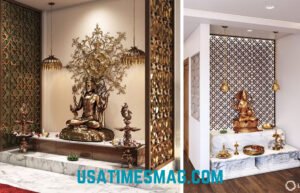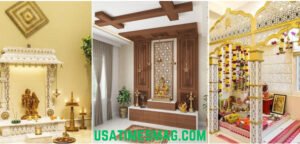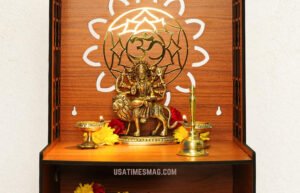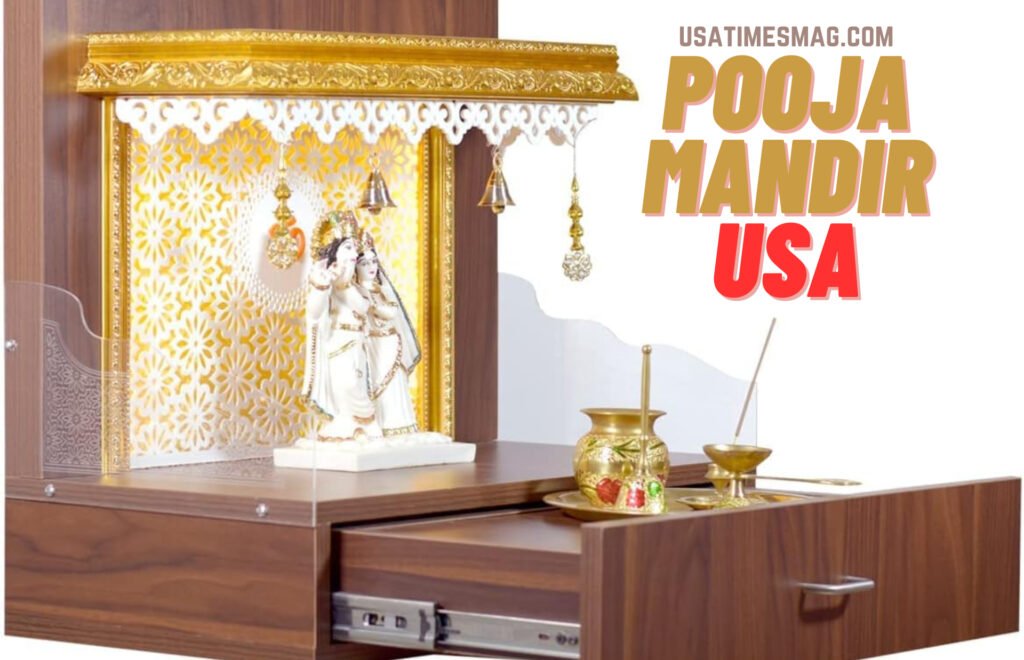In the United States, the concept of a “Pooja Mandir USA“—a dedicated space for Hindu worship—has evolved significantly, reflecting the rich tapestry of Indian culture and spirituality. As of 2024, these sacred spaces have become integral to many Indian-American households, serving as sanctuaries for prayer, meditation, and cultural preservation.
Table of Contents
ToggleThe Essence of Pooja Mandirs
A Pooja Mandir, or home temple, is a sacred space designated for performing daily rituals and prayers in Hinduism. Traditionally, these mandirs are intricately designed wooden or marble structures housing idols and images of deities, adorned with offerings, lamps, and other ritualistic items. They serve as focal points for spiritual activities, fostering a sense of peace and devotion within the home.
Evolution of Pooja Mandirs in the USA

The journey of Pooja Mandirs in the USA mirrors the broader narrative of the Indian diaspora. In the mid-20th century, as Indian immigrants settled across the country, they sought to recreate familiar spiritual environments. Initially, makeshift altars sufficed, but over time, the demand for authentic and aesthetically pleasing Pooja Mandirs grew. This evolution has led to a thriving market catering to diverse preferences and budgets.
Design and Customization Trends
Modern Pooja Mandirs in the USA exhibit a blend of traditional craftsmanship and contemporary design elements. Artisans and manufacturers offer a wide array of options, from compact wall-mounted units to elaborate freestanding structures. Customization is a key trend, allowing individuals to tailor their mandirs to specific dimensions, materials, and finishes that harmonize with their home decor.
For instance, companies like Pooja Mandirs USA provide custom-built mandirs with various sizes and options, including different stain colors, storage solutions, and layouts to suit individual preferences.
Similarly, Divine Wood N Crafts offers handcrafted mandirs made in the USA, emphasizing quality and personalization.
Materials and Craftsmanship

The choice of materials significantly influences the aesthetic and durability of Pooja Mandirs. Common materials include:
- Wood: Teak, rosewood, and sheesham are favored for their durability and intricate grain patterns. Wooden mandirs often feature detailed carvings and traditional motifs.
- Marble: Known for its elegance and ease of maintenance, marble mandirs are popular among those seeking a pristine and timeless look.
- Metal: Brass and copper mandirs offer a unique aesthetic and are appreciated for their longevity and traditional appeal.
Artisans pay meticulous attention to detail, incorporating elements like domes, pillars, and arches that reflect traditional Indian temple architecture. Hand-carved designs, intricate inlays, and ornamental features enhance the spiritual ambiance of these sacred spaces.
Integration into American Homes
Incorporating a Pooja Mandir into American homes requires thoughtful planning to ensure it aligns with both spiritual practices and modern living spaces. Key considerations include:
- Location: Selecting a quiet, clean, and elevated area, preferably facing east or north, is ideal for setting up a mandir.
- Size: The mandir should be proportionate to the available space, ensuring it is neither cramped nor overwhelming.
- Ventilation: Proper ventilation is essential, especially if rituals involve lighting lamps or incense.
- Storage: Incorporating drawers or cabinets within the mandir design can accommodate religious texts and ritual items, maintaining an organized and clutter-free space.
Cultural Significance and Community Impact

Beyond individual households, Pooja Mandirs play a pivotal role in fostering community cohesion among Indian-Americans. They serve as venues for communal prayers, festivals, and cultural gatherings, reinforcing shared values and traditions. The presence of these sacred spaces within homes and community centers underscores the importance of preserving cultural heritage in a multicultural society.
Challenges and Considerations
While the popularity of Pooja Mandirs has surged, several challenges persist:
- Space Constraints: Urban living often limits the availability of space for dedicated prayer areas, necessitating innovative design solutions.
- Regulatory Compliance: Ensuring that the installation of mandirs adheres to local building codes and regulations is crucial, particularly when involving structural modifications.
- Cultural Sensitivity: Balancing traditional practices with contemporary lifestyles requires sensitivity to both cultural norms and modern conveniences.
Future Outlook
As the Indian-American community continues to grow and evolve, the demand for Pooja Mandirs is expected to rise correspondingly. Advancements in design technology, coupled with a deeper appreciation for cultural heritage, will likely lead to more innovative and personalized mandir designs. Moreover, the integration of sustainable materials and eco-friendly practices in mandir construction is anticipated to align with broader environmental consciousness.
Conclusion
The journey of Pooja Mandirs in the USA reflects a harmonious blend of tradition and modernity. These sacred spaces not only fulfill spiritual needs but also serve as cultural anchors, preserving the rich heritage of Hinduism within the American landscape. As of 2024, the continued evolution of Pooja Mandirs underscores the resilience and adaptability of cultural practices, enriching the diverse tapestry of American society.
FAQs about Pooja Mandir USA
What materials are used in constructing pooja mandirs in the USA?
Pooja mandirs in the USA are crafted from various materials, including stain-grade Red Oak Ply, Pine molding, and trims. Columns and poles may feature wood species such as Red Oak, Maple, Cherry, Alder, and Pine. These materials are sourced from local lumber shops to ensure quality and durability.
What customization options are available for pooja mandirs?
Customers can personalize their pooja mandirs by selecting dimensions (length, depth, height), stain colors, storage solutions, and temple layouts. Additional features like pullout trays, drawers, ledges for picture frames, and decorative elements such as bells and hanging diyas are also available to tailor the mandir to individual preferences.
What are the typical dimensions of pooja mandirs offered in the USA?
Pooja mandirs are available in various sizes to accommodate different spaces. Standard dimensions range from 36 inches in length, 12 inches in depth, and 48 inches in height, up to 90 inches in length, 24 inches in depth, and 96 inches in height. Customers can choose sizes within these parameters to fit their specific needs.
What is the return and exchange policy for custom pooja mandirs?
Due to the personalized nature of custom pooja mandirs, returns and exchanges are generally not offered. For shipping orders, clients receive photographs of the completed mandir for approval before shipment. For pickups, clients can inspect the finished product in person prior to taking it home.
How are pooja mandirs packed and shipped within the USA?
Pooja mandirs are meticulously packed for shipping by creating custom wooden boxes using 3/8″ plywood sheets. Sensitive components are secured inside the mandir to protect them from potential damage during transit. This careful packaging ensures the mandir arrives safely at its destination.
Do manufacturers offer pooja mandir accessories?
Yes, manufacturers provide a range of accessories to complement pooja mandirs, including bells, hanging diyas, and decorative garlands. These additions enhance the aesthetic appeal and functionality of the mandir, allowing for a more personalized worship space.

